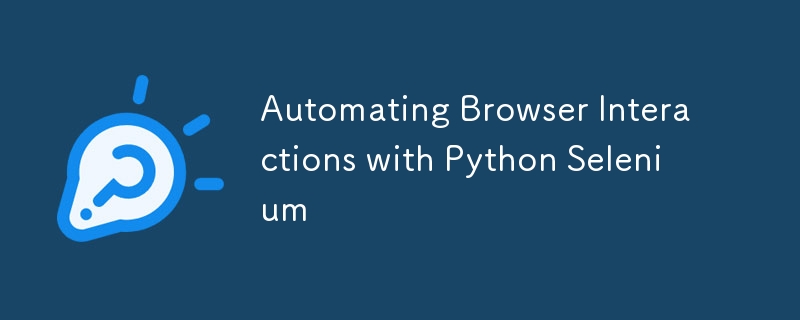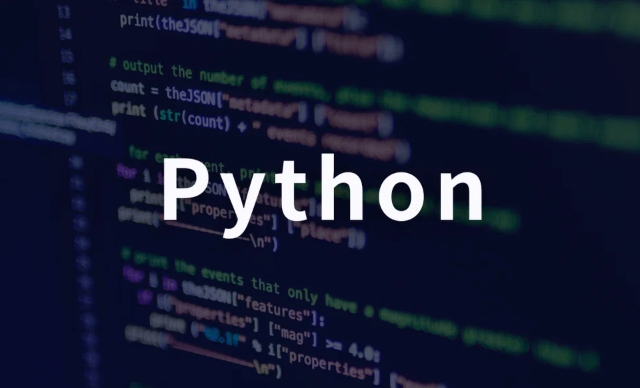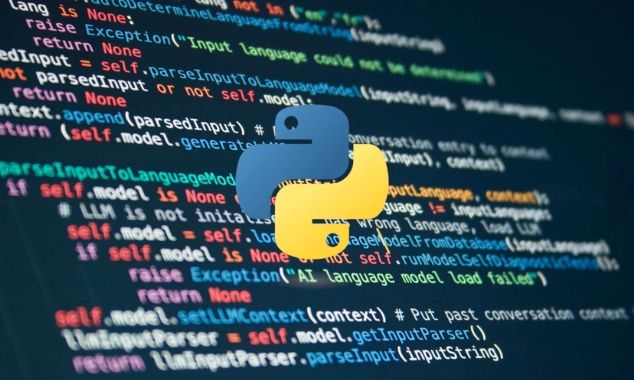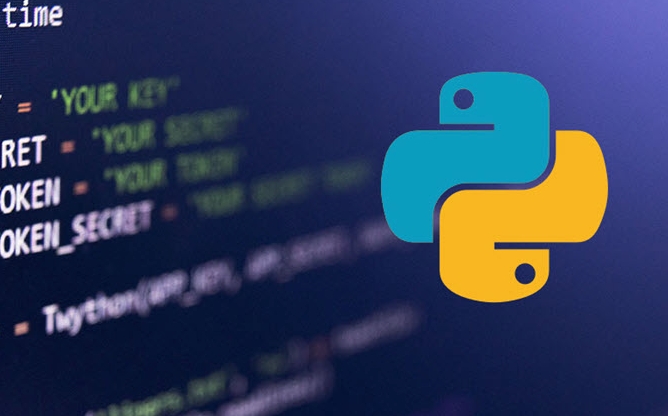Selenium is a powerful web automation tool that can be used to automatically log in, fill in forms, click buttons, and crawl data. First install Selenium and a matching browser driver (such as ChromeDriver or GeckoDriver) and configure the driver path. Then use webdriver to open the browser, locate elements and perform operations through find_element combined with By.ID, By.NAME, By.CSS_SELECTOR, etc. It is recommended to use explicit wait (WebDriverWait) to handle page load delays, use driver.switch_to.alert to handle pop-ups, and use window_handles to switch windows. You can also use headless mode to run scripts, set window size, and save page status. After mastering these basic operations, you can complete most web page automation tasks.

Have you ever thought about using Python to automatically operate web pages? For example, automatically login, fill in forms, click buttons, or even crawl web page data? Selenium is such a powerful tool that allows you to use code to "simulate" people's operations on the browser.

Install Selenium and browser drivers
To get started with Selenium, you must first install it. You can quickly install it with pip:
pip install selenium
Next, you need to download the driver that matches the browser version. For example, Chrome browsers require ChromeDriver , and Firefox requires GeckoDriver. After downloading, add the driver path to the system environment variable, or manually specify the path in the code.

Basic operations: open the page, find elements, and execute actions
At the heart of Selenium is to simulate user behavior. You can open a web page, then find elements on the page and perform operations, such as clicking buttons, entering text, obtaining text content, etc.
from selenium import webdriver
from selenium.webdriver.common.by import By
driver = webdriver.Chrome() # or use Firefox and other driver.get("https://example.com")
# Find the input box and enter the contents search_box = driver.find_element(By.NAME, "q")
search_box.send_keys("Selenium Automation")
# Find the button and click search_button = driver.find_element(By.NAME, "btnK")
search_button.click()
# Close browser driver.quit() Common search methods include By.NAME , By.ID , By.CLASS_NAME , By.XPATH , By.CSS_SELECTOR . It is recommended to use By.ID or By.CSS_SELECTOR first, because they are more stable and more efficient.

Handle pop-up windows, switch windows, and wait for pages to load
During the web page automation process, you may encounter problems such as pop-up windows, new windows, or delayed page loading. Some additional processing skills are needed at this time:
Pop-up window processing : You can use
driver.switch_to.alertto handle alert or confirm pop-up in JavaScript.Switch window : After opening a new tab, you can use
driver.window_handlesto get all window handles and switch:driver.switch_to.window(driver.window_handles[1])
Wait for the page to load : don't rely on
time.sleep(), but use Explicit Wait:from selenium.webdriver.support.ui import WebDriverWait from selenium.webdriver.support import expected_conditions as EC element = WebDriverWait(driver, 10).until( EC.presence_of_element_located((By.ID, "myDynamicElement")) )
Some practical tips
- Screenshot save page status : very useful when debugging
driver.save_screenshot("page.png") - Set the browser window size : simulate access to different devices
driver.set_window_size(1920, 1080)
- Run in headless mode : suitable for running scripts in the background
options = webdriver.ChromeOptions() options.add_argument("--headless") driver = webdriver.Chrome(options=options)
Basically that's it. Selenium has much more than that, but mastering these basic operations can already complete most web page automation tasks. If you use it too much, you will find that although it is sometimes a bit slow, it is better to be flexible and able to cope with various web structures.
The above is the detailed content of Automating Browser Interactions with Python Selenium. For more information, please follow other related articles on the PHP Chinese website!

Hot AI Tools

Undress AI Tool
Undress images for free

Undresser.AI Undress
AI-powered app for creating realistic nude photos

AI Clothes Remover
Online AI tool for removing clothes from photos.

Clothoff.io
AI clothes remover

Video Face Swap
Swap faces in any video effortlessly with our completely free AI face swap tool!

Hot Article

Hot Tools

Notepad++7.3.1
Easy-to-use and free code editor

SublimeText3 Chinese version
Chinese version, very easy to use

Zend Studio 13.0.1
Powerful PHP integrated development environment

Dreamweaver CS6
Visual web development tools

SublimeText3 Mac version
God-level code editing software (SublimeText3)
 How to handle API authentication in Python
Jul 13, 2025 am 02:22 AM
How to handle API authentication in Python
Jul 13, 2025 am 02:22 AM
The key to dealing with API authentication is to understand and use the authentication method correctly. 1. APIKey is the simplest authentication method, usually placed in the request header or URL parameters; 2. BasicAuth uses username and password for Base64 encoding transmission, which is suitable for internal systems; 3. OAuth2 needs to obtain the token first through client_id and client_secret, and then bring the BearerToken in the request header; 4. In order to deal with the token expiration, the token management class can be encapsulated and automatically refreshed the token; in short, selecting the appropriate method according to the document and safely storing the key information is the key.
 Explain Python assertions.
Jul 07, 2025 am 12:14 AM
Explain Python assertions.
Jul 07, 2025 am 12:14 AM
Assert is an assertion tool used in Python for debugging, and throws an AssertionError when the condition is not met. Its syntax is assert condition plus optional error information, which is suitable for internal logic verification such as parameter checking, status confirmation, etc., but cannot be used for security or user input checking, and should be used in conjunction with clear prompt information. It is only available for auxiliary debugging in the development stage rather than substituting exception handling.
 What are python iterators?
Jul 08, 2025 am 02:56 AM
What are python iterators?
Jul 08, 2025 am 02:56 AM
InPython,iteratorsareobjectsthatallowloopingthroughcollectionsbyimplementing__iter__()and__next__().1)Iteratorsworkviatheiteratorprotocol,using__iter__()toreturntheiteratorand__next__()toretrievethenextitemuntilStopIterationisraised.2)Aniterable(like
 What are Python type hints?
Jul 07, 2025 am 02:55 AM
What are Python type hints?
Jul 07, 2025 am 02:55 AM
TypehintsinPythonsolvetheproblemofambiguityandpotentialbugsindynamicallytypedcodebyallowingdeveloperstospecifyexpectedtypes.Theyenhancereadability,enableearlybugdetection,andimprovetoolingsupport.Typehintsareaddedusingacolon(:)forvariablesandparamete
 How to iterate over two lists at once Python
Jul 09, 2025 am 01:13 AM
How to iterate over two lists at once Python
Jul 09, 2025 am 01:13 AM
A common method to traverse two lists simultaneously in Python is to use the zip() function, which will pair multiple lists in order and be the shortest; if the list length is inconsistent, you can use itertools.zip_longest() to be the longest and fill in the missing values; combined with enumerate(), you can get the index at the same time. 1.zip() is concise and practical, suitable for paired data iteration; 2.zip_longest() can fill in the default value when dealing with inconsistent lengths; 3.enumerate(zip()) can obtain indexes during traversal, meeting the needs of a variety of complex scenarios.
 Python FastAPI tutorial
Jul 12, 2025 am 02:42 AM
Python FastAPI tutorial
Jul 12, 2025 am 02:42 AM
To create modern and efficient APIs using Python, FastAPI is recommended; it is based on standard Python type prompts and can automatically generate documents, with excellent performance. After installing FastAPI and ASGI server uvicorn, you can write interface code. By defining routes, writing processing functions, and returning data, APIs can be quickly built. FastAPI supports a variety of HTTP methods and provides automatically generated SwaggerUI and ReDoc documentation systems. URL parameters can be captured through path definition, while query parameters can be implemented by setting default values ??for function parameters. The rational use of Pydantic models can help improve development efficiency and accuracy.
 How to test an API with Python
Jul 12, 2025 am 02:47 AM
How to test an API with Python
Jul 12, 2025 am 02:47 AM
To test the API, you need to use Python's Requests library. The steps are to install the library, send requests, verify responses, set timeouts and retry. First, install the library through pipinstallrequests; then use requests.get() or requests.post() and other methods to send GET or POST requests; then check response.status_code and response.json() to ensure that the return result is in compliance with expectations; finally, add timeout parameters to set the timeout time, and combine the retrying library to achieve automatic retry to enhance stability.
 Setting Up and Using Python Virtual Environments
Jul 06, 2025 am 02:56 AM
Setting Up and Using Python Virtual Environments
Jul 06, 2025 am 02:56 AM
A virtual environment can isolate the dependencies of different projects. Created using Python's own venv module, the command is python-mvenvenv; activation method: Windows uses env\Scripts\activate, macOS/Linux uses sourceenv/bin/activate; installation package uses pipinstall, use pipfreeze>requirements.txt to generate requirements files, and use pipinstall-rrequirements.txt to restore the environment; precautions include not submitting to Git, reactivate each time the new terminal is opened, and automatic identification and switching can be used by IDE.






